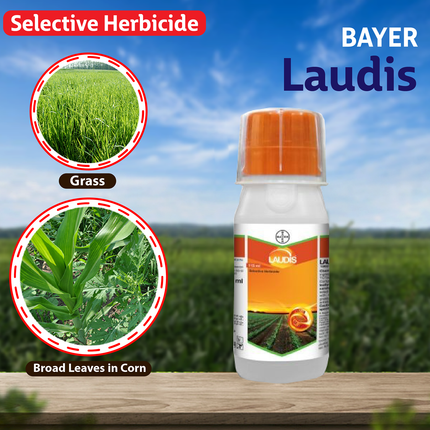Description
Product Description
Laudis Herbicide is a broad-spectrum post-emergence herbicide that controls a wide range of annual broadleaf and grassy weeds in corn. It is effective on tough to control glyphosate-resistant weeds such as giant ragweed, kochia, volunteer canola, and waterhemp. Laudis also has residual activity, providing up to 3 weeks of weed control.
Active Ingredients
-
The active ingredient in Bayer Laudis Herbicide is tembotrione. Tembotrione is a Group 27 herbicide, which means that it works by inhibiting the activity of the 4-hydroxy-phenyl-pyruvate-dioxygenase (4-HPPD) enzyme. This enzyme is involved in the synthesis of carotenoids, which are plant pigments that protect chlorophyll from damage by sunlight. When tembotrione inhibits the activity of 4-HPPD, it causes the plant to lose its carotenoids, which leads to chlorophyll bleaching and eventually plant death.
Mode of Action
Here is a more detailed explanation of the mode of action of tembotrione:
-
Carotenoids are plant pigments that are responsible for giving plants their yellow, orange, and red colors. They also play an important role in protecting chlorophyll from damage by sunlight.
-
Chlorophyll is the green pigment that is responsible for photosynthesis. It absorbs sunlight and uses the energy to convert carbon dioxide and water into glucose.
-
4-HPPD is an enzyme that is involved in the synthesis of carotenoids. It converts 4-hydroxyphenyl pyruvate into 4-hydroxyphenyl-acetaldehyde, which is a precursor to carotenoids.
-
When tembotrione binds to 4-HPPD, it prevents the enzyme from converting 4-hydroxyphenyl pyruvate into 4-hydroxyphenyl-acetaldehyde. This blocks the synthesis of carotenoids, which leads to chlorophyll bleaching and eventually plant death.
Benefits
-
Effective on a wide range of weeds: It controls a wide range of annual broadleaf and grassy weeds in corn, including some that are resistant to other herbicides.
-
Has residual activity: Laudis Herbicide provides weed control for up to 3 weeks after application. This means that you only need to apply it once, and it will continue to control weeds for several weeks.
-
Easy to use: It can be applied with a variety of equipment, including ground sprayers, aerial sprayers, and backpack sprayers. It is also compatible with many other herbicides, making it a versatile tool for weed control.
-
Safe for corn: Laudis Herbicide is safe for corn, so it can be used safely to control weeds in cornfields.
|
Crop
|
Weeds
|
Dosage (mL/ha)
|
Dosage (mL/ac.)
|
|
Corn
|
Annual broadleaf and grassy weeds
|
110-220
|
44-89
|
|
Corn
|
Giant ragweed, kochia, volunteer canola, and waterhemp
|
220
|
89
|
It is important to note that these are just general guidelines, and the specific dosage and application rate may vary depending on the crop, the severity of the disease, and the environmental conditions. It is always best to consult the product label for specific instructions.
